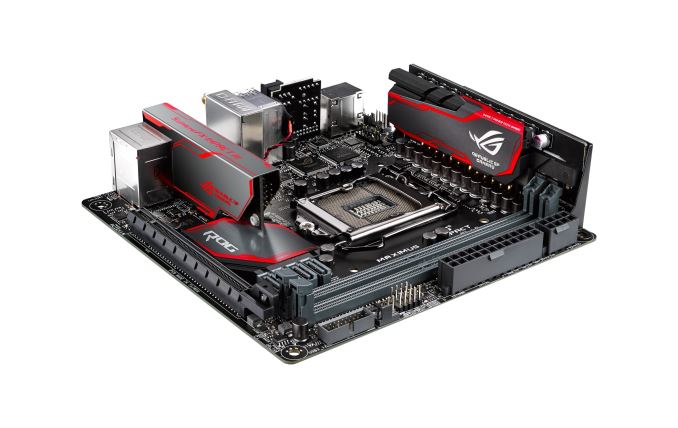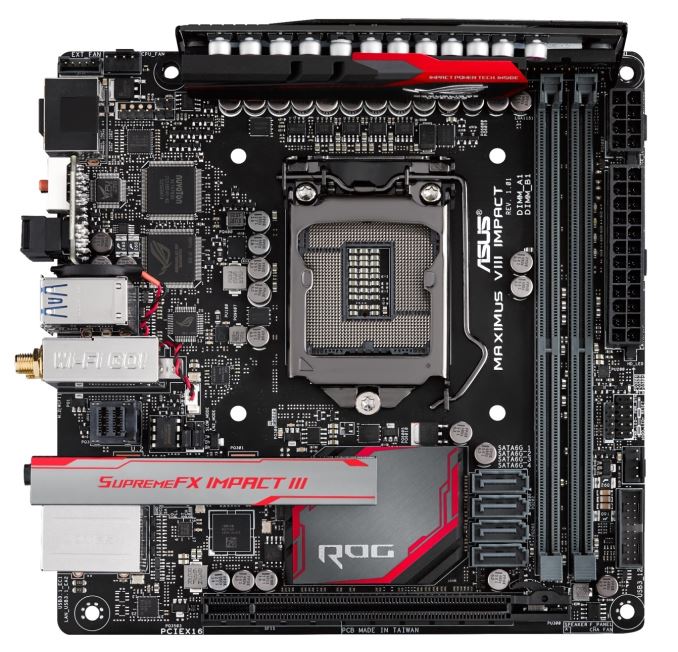ASUS Announces the ROG Maximus VIII Impact Z170 Motherboard
by Ian Cutress on October 10, 2015 12:30 PM EST
At the initial Skylake launch, we provided a rundown of all the Z170 motherboards we could get information on from the major motherboard manufacturers. Even with details on over 55 motherboards, there were some noticeable parts missing from that list as we were told to expect more as the platform developed. The Maximus VIII Impact from ASUS is one of those to come a couple of months after the initial launch, and builds on the previous Impact products from the Republic of Gamers brand.
As with other Impact motherboards, the major difference between it and other mini-ITX motherboards is the power delivery on a right-angled daughter board at the top. This allows ASUS to provide a larger power sub-system, cool it appropriately, and over the multi-generational iterative design we are told the power losses involved with this method are continually minimised. From the images it is difficult to make out, but the Z170 generation of the Impact comes with a rear metal guard (look on the right hand side and over the motherboard screw hole in the top right corner). Presumably this is either for rigidity or for extra PWM cooling. Also as with other Impact designs, the power connectors are on the right hand side of the board, outside the DRAM slots, to make them easier to access for cable management. Underneath this is the front IO panel, a fan header and a USB 3.0 header from the chipset.
Being a mini-ITX board, there is really only space for two DRAM slots, and the Impact uses dual DDR4 slots with single-sided latches and support for 32GB and DDR4-4133. The latches for the slots are on the PCIe side due to the power delivery daughterboard, which might make DRAM removal with large GPUs installed more difficult. Inside the DRAM slots are four SATA 6 Gbps ports, but storage is aided by a U.2 connector near the rear panel. This is done due to the size of the U.2 connector, and it’s great to have the functionality, though it does mean that SSD 750 owners will be routing the cable over the motherboard to get to it in most cases. Back at the launch of the Z170 chipset, after the SSD 750 had been out for a month, I spoke to motherboard manufacturers about actually replacing SATA Express with U.2 onboard – here’s one of the first examples (there are a couple of others).
The last generation Impact came with an additional daughterboard for extra fan headers, to aid the two already on the motherboard. Here, instead of that daughterboard, we get the EXT_FAN header in the top right which is a breakout connector to a separate PCB containing fan headers and power. When talking to ASUS about this on previous designs, the move towards the fact that Impact owners tend to have customized systems, so having this option allows them to have a more configurable system design.
While we don’t have HDMI 2.0 here, ASUS seems to be using Intel’s Alpine Ridge controller to provide two USB 3.1 ports at 10 Gbps with type-A and type-C support. There are two Intel ICs next to the USB 3.1 ports, the smaller of which is the network controller and the larger seems to be the Alpine Ridge and is similar to other implementations – there isn’t an ASMedia controller nearby at any rate. This would be one of the first times we’ve seen the Alpine Ridge controller outside of GIGABYTE boards, perhaps suggesting that their launch day exclusivity has now come to an end. ASUS also puts on the board an Intel I219-V network controller, a 2x2 MU-MIMO 802.11ac Wi-Fi Go module, and their SupremeFX Impact III daughterboard audio solution, now encased in a full EM shield and with LED-illuminated audio jacks and headphone impedance detection/adjustment up to 600 ohms. The rear panel also supports BIOS flashback, four USB 3.0 ports, and their Impact Control III information/control panel.
Because this information is from the ROG team and not an ASUS regional office, pricing and availability is not yet known. Although typically an ROG team announcement in the past has become a 2-4 week lead time to US deployment in the past, and previous Impact motherboards have been in the $230-$280 area.
Source: ASUS ROG
Update 10/11: We've been told that the Max VIII Impact will retail for around $249 and be available next week in North America.















45 Comments
View All Comments
adenta180 - Sunday, October 11, 2015 - link
These are practically all interfaces for exposing a PCIE x4 connection, I don't see any one kind better than another from a performance perspective. However, an U.2 instead of M.2 at this time point does suffer from much less choice of SSD devices.OTOH, I'm not a fan of putting the M.2 on the back either; how are to supposed to cool it that way?
edzieba - Sunday, October 11, 2015 - link
Thermal pad to couple it to the backplate. Those m.2 drives are well under 10W, they don't need active cooling.An m.2 to u.2 adapter isn't difficult (there are several already available), but a u.2 to m.2 adapter requires an additional power supply input. Omitting m.2 for an ITX board is bonkers.
Rajinder Gill - Sunday, October 11, 2015 - link
M.2 has power constraints that limit it to 25W - to get consistent perf, higher peak currents are required. That and thermal issues that can ocur in limited space, make U.2 a better option for this type of board.edzieba - Monday, October 12, 2015 - link
The SM951 is under 9W at peak (and because people are grabbing OEM drives, there's no power management), and the 950 Pro is even lower. Thermal dissipation is not a limiting issue for m.2 drives, particularly with chassis coupling. u.2 is as poor a solution for ITX as 2.5" SATA drives are: it's a bunch of wasted volume and extra cabling.If you;re building what is effectivley an ATX PC with a smaller motherboard it might be fine, but for an actually small Pc where ITX is important, m.2 is vital for reducing volume.
Rajinder Gill - Wednesday, October 14, 2015 - link
The SM951 is a drive that is very capable of throttling - something we would have to work around. On the engineering side, including M.2 would also have required additional layers and cost if we were to add it. U.2 is the best solution at present. We cannot keep everyonme people happy with a board like this - I prefer that we opted for U.2 over M.2.NovumDives - Monday, October 19, 2015 - link
That's exactly who this board is made for. If you want an ultra small kiosk box or something of that nature, a gaming motherboard isn't the right solution. 99% of buyers are putting a full size graphics card in the PCI x16 slot and running a gaming PC. U.2 is exactly the right solution.FriendlyUser - Sunday, October 11, 2015 - link
This is certainly not a bad product, but the price is quite high and I don't really get the ROG branding. I would expect the typical ROG client to have a massive tower with multiple GPUs, not caring about a small form factor. Anyway, more choice is good, but people buying small form factors are likely to be more sensitive to price and less impressed by flashy colors and LEDs.Disclaimer: I own a ROG m/b and am reasonably happy with it.
doggface - Sunday, October 11, 2015 - link
Personally, I am tired of giant towers. If I could fit a powerful system into a mini-itx case I would be thrilled. This is a no compromises product in many ways and has a price tag to match.Also, +1 for happy to see U.2 making more of an appearance. Glad to see it on boards as I personally think it is the replacement to sata that sata express never was, that we have been waiting for.
Morawka - Tuesday, October 13, 2015 - link
i like a small footprint to, but you'll also get tired of having to pull the motherboard, cooling, gpu' etc.. everytime you want to add a SSD.Morawka - Tuesday, October 13, 2015 - link
And repaste your cpu..